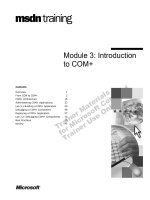Tài liệu CNNA3-Chapter 3 pdf
Bạn đang xem bản rút gọn của tài liệu. Xem và tải ngay bản đầy đủ của tài liệu tại đây (1.35 MB, 46 trang )
CCNA3-1
Chapter 3-1
Chapter 3
Chapter 3
Virtual Local Area Networks
Virtual Local Area Networks
(VLANs)
(VLANs)
Part I
Part I
CCNA3-2
Chapter 3-1
Virtual Local Area Networks
Virtual Local Area Networks
Introducing VLANs
Introducing VLANs
CCNA3-3
Chapter 3-1
Defining VLANs
Defining VLANs
•
In
In
traditional
traditional
switched LANs,
switched LANs,
the physical topology is
the physical topology is
closely related to the logical
closely related to the logical
topology.
topology.
•
Generally, workstations must
Generally, workstations must
be
be
grouped by their physical
grouped by their physical
proximity to a switch
proximity to a switch
.
.
•
To communicate among
To communicate among
LANs, each segment must
LANs, each segment must
have a
have a
separate port
separate port
on the
on the
backbone device or a
backbone device or a
connection to a common
connection to a common
backbone.
backbone.
Separate Broadcast
Separate Broadcast
Domains
Domains
Separate Broadcast
Separate Broadcast
Domains
Domains
CCNA3-4
Chapter 3-1
Defining VLANs
Defining VLANs
•
VLANs provide segmentation
VLANs provide segmentation
based on
based on
broadcast domains
broadcast domains
.
.
•
VLANs logically segment
VLANs logically segment
switched networks based on
switched networks based on
the
the
functions, project teams,
functions, project teams,
or applications
or applications
of the
of the
organization
organization
regardless of the
regardless of the
physical location
physical location
or
or
connections to the network.
connections to the network.
•
Communication among
Communication among
VLANs still require a router.
VLANs still require a router.
BUT,
BUT,
only one physical
only one physical
connection
connection
will handle all
will handle all
routing.
routing.
Separate Broadcast
Separate Broadcast
Domains
Domains
Separate Broadcast
Separate Broadcast
Domains
Domains
CCNA3-5
Chapter 3-1
Defining VLANs
Defining VLANs
•
VLANs are created to provide segmentation services
VLANs are created to provide segmentation services
traditionally provided by physical routers in LAN
traditionally provided by physical routers in LAN
configurations.
configurations.
•
They address:
They address:
•
Scalability
Scalability
•
Security
Security
•
Network Management
Network Management
•
Broadcast Filtering
Broadcast Filtering
•
Traffic Flow Management
Traffic Flow Management
•
Switches
Switches
may not forward
may not forward
any traffic between VLANs, as this
any traffic between VLANs, as this
would violate the integrity of the VLAN broadcast domain.
would violate the integrity of the VLAN broadcast domain.
•
Traffic
Traffic
must be routed
must be routed
between VLANs.
between VLANs.
CCNA3-6
Chapter 3-1
What Does This Mean?
What Does This Mean?
Requirements:
Requirements:
- Different department on
- Different department on
each floor.
each floor.
- Three different LANs per floor.
- Three different LANs per floor.
- Separate networks
- Separate networks
Requirements:
Requirements:
- Different department on
- Different department on
each floor.
each floor.
- Three different LANs per floor.
- Three different LANs per floor.
- Separate networks
- Separate networks
With routers:
With routers:
Expen
Expen
$
$
ive!
ive!
-
4 Ports each
4 Ports each
-
3 hubs / floor
3 hubs / floor
-
10 Broadcast domains
10 Broadcast domains
- Inefficient traffic flow
- Inefficient traffic flow
With routers:
With routers:
Expen
Expen
$
$
ive!
ive!
-
4 Ports each
4 Ports each
-
3 hubs / floor
3 hubs / floor
-
10 Broadcast domains
10 Broadcast domains
- Inefficient traffic flow
- Inefficient traffic flow
CCNA3-7
Chapter 3-1
What Does This Mean?
What Does This Mean?
With switches:
With switches:
-
More scalable
More scalable
-
Easier to manage
Easier to manage
-
1 Router
1 Router
-
3 Broadcast Domains
3 Broadcast Domains
- Efficient traffic flow
- Efficient traffic flow
With switches:
With switches:
-
More scalable
More scalable
-
Easier to manage
Easier to manage
-
1 Router
1 Router
-
3 Broadcast Domains
3 Broadcast Domains
- Efficient traffic flow
- Efficient traffic flow
CCNA3-8
Chapter 3-1
Defining VLANs
Defining VLANs
•
A VLAN, then, is a broadcast domain (IP Subnet) created by
A VLAN, then, is a broadcast domain (IP Subnet) created by
one or more switches.
one or more switches.
CCNA3-9
Chapter 3-1
Defining VLANs
Defining VLANs
•
The above design shows 3 separate broadcast domains
The above design shows 3 separate broadcast domains
created using one router with 3 ports and 3 switches.
created using one router with 3 ports and 3 switches.
•
The router filters the broadcasts for each LAN.
The router filters the broadcasts for each LAN.
CCNA3-10
Chapter 3-1
Defining VLANs
Defining VLANs
•
A better design still creates the 3 separate broadcast
A better design still creates the 3 separate broadcast
domains but only requires 1 switch.
domains but only requires 1 switch.
•
The router provides broadcast filtering over a
The router provides broadcast filtering over a
single link
single link
.
.
One Physical
One Physical
Link
Link
One Physical
One Physical
Link
Link
CCNA3-11
Chapter 3-1
Defining VLANs
Defining VLANs
•
A VLAN allows:
A VLAN allows:
•
Creation of groups of logically networked devices.
Creation of groups of logically networked devices.
•
The devices to act as if they are on their own
The devices to act as if they are on their own
independent network.
independent network.
•
The devices can share a common infrastructure.
The devices can share a common infrastructure.
•
Each VLAN is a separate broadcast domain.
Each VLAN is a separate broadcast domain.
•
Broadcast traffic is controlled.
Broadcast traffic is controlled.
•
Each VLAN is a separate IP subnet.
Each VLAN is a separate IP subnet.
•
To communicate among VLANs, you must use a
To communicate among VLANs, you must use a
router (
router (
MUCH
MUCH
more later).
more later).
CCNA3-12
Chapter 3-1
Benefits of VLANs
Benefits of VLANs
•
Security:
Security:
•
Groups with specific security needs are isolated from the
Groups with specific security needs are isolated from the
rest of the network.
rest of the network.
•
Cost Reduction:
Cost Reduction:
•
Need for expensive hardware upgrades is reduced.
Need for expensive hardware upgrades is reduced.
•
Better use of existing bandwidth and links.
Better use of existing bandwidth and links.
•
Higher Performance:
Higher Performance:
•
Dividing large, flat Layer 2 networks into separate
Dividing large, flat Layer 2 networks into separate
broadcast domains reduces unnecessary traffic on each
broadcast domains reduces unnecessary traffic on each
new subnet.
new subnet.
CCNA3-13
Chapter 3-1
Benefits of VLANs
Benefits of VLANs
•
Broadcast Storm Mitigation:
Broadcast Storm Mitigation:
•
Dividing a network into VLANs prevents a broadcast
Dividing a network into VLANs prevents a broadcast
storm from propagating to the whole network.
storm from propagating to the whole network.
•
Improved IT Staff Efficiency:
Improved IT Staff Efficiency:
•
Easier to manage the network because users with similar
Easier to manage the network because users with similar
network requirements share the same VLAN.
network requirements share the same VLAN.
•
Simpler Project or Application Management:
Simpler Project or Application Management:
•
Having separate functions makes working with a
Having separate functions makes working with a
specialized application easier. For example, an
specialized application easier. For example, an
e-learning development platform for faculty.
e-learning development platform for faculty.
CCNA3-14
Chapter 3-1
VLAN ID Ranges
VLAN ID Ranges
•
When configured, the number that is assigned to the VLAN
When configured, the number that is assigned to the VLAN
becomes the VLAN ID.
becomes the VLAN ID.
•
The numbers to be assigned are divided into two different
The numbers to be assigned are divided into two different
ranges:
ranges:
•
Normal Range:
Normal Range:
1 – 1005
1 – 1005
•
Extended Range:
Extended Range:
1006 - 4096
1006 - 4096
•
Each range has its own characteristics.
Each range has its own characteristics.
CCNA3-15
Chapter 3-1
VLAN ID Ranges
VLAN ID Ranges
•
Normal Range:
Normal Range:
1 – 1005
1 – 1005
•
Used in small- and medium-sized business and
Used in small- and medium-sized business and
enterprise networks.
enterprise networks.
•
IDs 1002 – 1005: Token Ring and FDDI VLANs.
IDs 1002 – 1005: Token Ring and FDDI VLANs.
•
IDs 1 and 1002 to 1005 are automatically created and
IDs 1 and 1002 to 1005 are automatically created and
cannot be removed.
cannot be removed.
•
Configurations are stored within a VLAN database file,
Configurations are stored within a VLAN database file,
called
called
vlan.dat
vlan.dat
,
,
located in the
located in the
flash
flash
memory of the switch.
memory of the switch.
•
The VLAN Trunking Protocol
The VLAN Trunking Protocol
(VTP)
(VTP)
, which helps manage
, which helps manage
VLAN configurations between switches,
VLAN configurations between switches,
can only learn
can only learn
normal range VLANs
normal range VLANs
and stores them in the VLAN
and stores them in the VLAN
database file.
database file.
(Chapter 4)
(Chapter 4)
CCNA3-16
Chapter 3-1
VLAN ID Ranges
VLAN ID Ranges
•
Extended Range:
Extended Range:
1006 – 4096
1006 – 4096
•
Enable service providers to extend their infrastructure to
Enable service providers to extend their infrastructure to
a greater number of customers.
a greater number of customers.
•
Some global enterprises could be large enough to need
Some global enterprises could be large enough to need
extended range VLAN IDs.
extended range VLAN IDs.
•
Support fewer VLAN features than normal range VLANs.
Support fewer VLAN features than normal range VLANs.
•
Are saved in the running configuration file – not the
Are saved in the running configuration file – not the
vlan.dat file.
vlan.dat file.
•
VTP does not learn extended range VLANs
VTP does not learn extended range VLANs
.
.
CCNA3-17
Chapter 3-1
Types of VLANs
Types of VLANs
•
Traditionally, two methods of implementing VLANs:
Traditionally, two methods of implementing VLANs:
•
Static or Port-Based:
Static or Port-Based:
•
Ports on a switch are assigned to a specific VLAN.
Ports on a switch are assigned to a specific VLAN.
•
Dynamic:
Dynamic:
•
VLANs created by accessing a Network Management
VLANs created by accessing a Network Management
server. The MAC address/VLAN ID mapping is set up
server. The MAC address/VLAN ID mapping is set up
by the Network Administrator and the server assigns a
by the Network Administrator and the server assigns a
VLAN ID when the device contacts it.
VLAN ID when the device contacts it.
•
Today, there is essentially one method of implementing
Today, there is essentially one method of implementing
VLANs:
VLANs:
Port-Based
Port-Based
.
.
CCNA3-18
Chapter 3-1
Types of Port-Based VLANs
Types of Port-Based VLANs
•
Defined by the type of traffic they support or by the functions
Defined by the type of traffic they support or by the functions
they perform.
they perform.
•
Data
Data
VLAN.
VLAN.
•
Default
Default
VLAN.
VLAN.
•
Native
Native
VLAN.
VLAN.
•
Management
Management
VLAN.
VLAN.
•
Voice
Voice
VLAN.
VLAN.
CCNA3-19
Chapter 3-1
Types of Port-Based VLANs
Types of Port-Based VLANs
•
Data VLAN:
Data VLAN:
•
Configured to carry only user-generated traffic.
Configured to carry only user-generated traffic.
•
A switch could carry voice-based traffic or traffic used to
A switch could carry voice-based traffic or traffic used to
manage the switch, but this traffic would not be part of a
manage the switch, but this traffic would not be part of a
data VLAN.
data VLAN.
•
A
A
Data VLAN
Data VLAN
is sometimes referred to as a
is sometimes referred to as a
User VLAN
User VLAN
.
.
CCNA3-20
Chapter 3-1
Types of Port-Based VLANs
Types of Port-Based VLANs
•
Default VLAN:
Default VLAN:
•
The default VLAN for Cisco switches is VLAN 1.
The default VLAN for Cisco switches is VLAN 1.
•
VLAN 1 has all the features of any VLAN, except that you
VLAN 1 has all the features of any VLAN, except that you
cannot rename it and you can not delete it
cannot rename it and you can not delete it
.
.
•
By default, Layer 2
By default, Layer 2
control traffic
control traffic
(CDP and STP) is
(CDP and STP) is
associated with VLAN 1.
associated with VLAN 1.
•
It is a
It is a
security best practice
security best practice
to change the default VLAN
to change the default VLAN
to a VLAN other than VLAN 1 (e.g. VLAN 99).
to a VLAN other than VLAN 1 (e.g. VLAN 99).
•
VLAN Trunk:
VLAN Trunk:
•
Carries data or control information (VLAN 1 data) for
Carries data or control information (VLAN 1 data) for
all VLANs from switch-to-switch or switch-to-router.
all VLANs from switch-to-switch or switch-to-router.
CCNA3-21
Chapter 3-1
Types of Port-Based VLANs
Types of Port-Based VLANs
•
Native VLAN:
Native VLAN:
•
An 802.1Q trunk port supports traffic coming from VLANs
An 802.1Q trunk port supports traffic coming from VLANs
(tagged traffic)
(tagged traffic)
as well as traffic that does not come from
as well as traffic that does not come from
a VLAN
a VLAN
(untagged traffic)
(untagged traffic)
.
.
•
The 802.1Q trunk port places
The 802.1Q trunk port places
untagged traffic on the
untagged traffic on the
native VLAN
native VLAN
.
.
•
Native VLANs are set out in the IEEE 802.1Q
Native VLANs are set out in the IEEE 802.1Q
specification to
specification to
maintain backward compatibility
maintain backward compatibility
with
with
untagged traffic common to legacy LAN scenarios.
untagged traffic common to legacy LAN scenarios.
•
It is a best practice to use a
It is a best practice to use a
VLAN other than VLAN 1
VLAN other than VLAN 1
as
as
the native VLAN.
the native VLAN.
CCNA3-22
Chapter 3-1
Types of Port-Based VLANs
Types of Port-Based VLANs
•
Management VLAN:
Management VLAN:
•
A management VLAN is any VLAN you configure to
A management VLAN is any VLAN you configure to
access the management capabilities
access the management capabilities
of a switch.
of a switch.
•
You assign the management VLAN an IP address and
You assign the management VLAN an IP address and
subnet mask.
subnet mask.
•
A new switch has all ports assigned to VLAN 1.
A new switch has all ports assigned to VLAN 1.
•
Using VLAN 1 as the management VLAN means that
Using VLAN 1 as the management VLAN means that
anyone connecting to the switch
anyone connecting to the switch
will be in the
will be in the
management VLAN.
management VLAN.
•
That assumes that all ports have not been assigned to
That assumes that all ports have not been assigned to
another VLAN.
another VLAN.
CCNA3-23
Chapter 3-1
Types of Port-Based VLANs
Types of Port-Based VLANs
•
Voice VLANs:
Voice VLANs:
•
Voice-over-IP
Voice-over-IP
(VoIP)
(VoIP)
traffic requires:
traffic requires:
•
Assured bandwidth
Assured bandwidth
to ensure voice quality.
to ensure voice quality.
•
Transmission priority
Transmission priority
over other types of network
over other types of network
traffic.
traffic.
•
Ability to be routed
Ability to be routed
around congested areas on the
around congested areas on the
network.
network.
•
Delay of less than 150 milliseconds
Delay of less than 150 milliseconds
(ms) across the
(ms) across the
network.
network.
•
The details of how to configure a network to support VoIP
The details of how to configure a network to support VoIP
are beyond the scope of the course, but it is useful to
are beyond the scope of the course, but it is useful to
summarize how a voice VLAN works between
summarize how a voice VLAN works between
a switch, a
a switch, a
Cisco IP phone, and a computer.
Cisco IP phone, and a computer.
CCNA3-24
Chapter 3-1
Types of Port-Based VLANs
Types of Port-Based VLANs
•
Voice VLANs:
Voice VLANs:
VLAN 150 is designed
VLAN 150 is designed
to carry voice traffic.
to carry voice traffic.
VLAN 150 is designed
VLAN 150 is designed
to carry voice traffic.
to carry voice traffic.
Connections
Connections
Connections
Connections
CCNA3-25
Chapter 3-1
Types of Port-Based VLANs
Types of Port-Based VLANs
•
Voice VLANs:
Voice VLANs:
A Cisco IP Phone is a switch.
A Cisco IP Phone is a switch.
Port 1
Port 1
connects to the
connects to the
switch or VoIP device.
switch or VoIP device.
Port 1
Port 1
connects to the
connects to the
switch or VoIP device.
switch or VoIP device.
Port 3
Port 3
connects to a
connects to a
PC or other device.
PC or other device.
Port 3
Port 3
connects to a
connects to a
PC or other device.
PC or other device.









